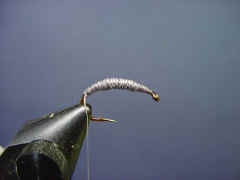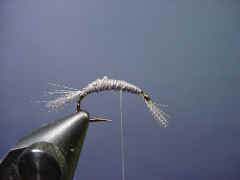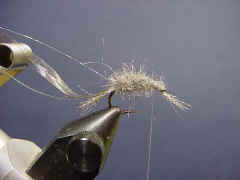|
Fly of the Month Bob Ireton brings together his experience in fly fishing, aquatic entomology, and knowledge of fly tying techniques and materials, to design and tie durable and effective flies. |

|
![]()
Volume 3, Issue 7
July 2002
![]()
GRAY SCUD
Fly and Text by Bob Ireton
Photography by Bob Kimsey and Bob Ireton
Scuds are crustaceans that live in and on
aquatic vegetation. They are important and can be found in nearly every pond
and lake you'll fish, and in most moving waters slow enough to allow
vegetation to take root. Scuds often reach dense populations in spring creeks
and tailwaters with stabilized flows, and beds of attached algae and rooted
plant beds. Because they have no set mating and emergence period, these
crustaceans are in the water at mature size, and available at all times of the
year.
Scuds vary in size from 5 to 25mm, and occur in colors of yellow, olive, gray,
and tan. They usually turn a pale to dark orange when they die. Fish this fly
in and around the habitats they are found either dead drift, or with a slow,
twitching retrieve.
MATERIALS
Hook - TMC 2457, 2487, Dai-Rikki 135, Daiichi 1150, 1130, 1120,
Mustad 80250BR, 80200BR Size 10-18Thread - 6/0 for size 12 and larger, and 8/0 for size 14 and smaller
Antennae - Gray mallard flank feather fibers
Tail - Gray mallard flank feather fibers
Back - Gray scud back or equivalent, with pearl flashabou underneath
Rib - 6X tippet material, or equivalent
Abdomen/Underbody - Scud gray dubbing
TYING STEPS
![]()
Copyright © 1998 - thisyear The Buckeye United Fly Fishers, Inc. Cincinnati, OH 45242
The Buckeye United Fly Fishers, Inc is a non-profit corporation organized under section 501(c)(3) of the Internal Revenue Code, incorporated in the State of Ohio for the preservation, conservation and wise use of our fishing waters and game fish; and to assist in the protection and improvement of our natural resources




